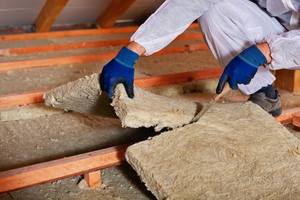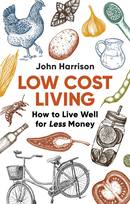“Heat rises” are the two words which sum up the need for good loft insulation and if done correctly, your heating bills will show a dramatic reduction. 25 to 35% of home heat lost is through the roof. Loft insulation is about the most cost-effective insulation to install and roll materials can be installed as a DIY job.

Laying Mineral Wool Loft Insulation
Check around for special deals and subsidised prices, some energy companies sell loft insulation at very low prices to help with energy saving.
What Thickness of Loft Insulation to Use?
Currently the recommended depth of blanket style insulation (fibre glass or mineral wool) for a loft is 250 to 270 mm or 10 inches. Back in the 1970’s it was 100mm, 4 inches which was doubled to 200mm before the current recommendation.
Since fuel prices are going to rise on average as time goes on, I’d suggest more is better.
If your loft is already insulated, check the depth because it could be well worth your time to top it up. Don’t bother taking old insulation out, just lay on top of it.- we’ve got about 400mm in most of our loft on top of 100mm loose fill insulation.
What Insulation to Use?
Fiberglass or Mineral Wool Roll Insulation
This comes in rolls – check the length and thickness when buying. It’s easy enough to lay but it’s not a nice job. Wear a dust mask, gloves and goggles. The little particles that come off the material are really irritating and itchy. I’d suggest a good shower immediately on finishing!
Lay initially between the joists and then the next layer at right angles, across that. The third layer is in the same direction as the base layer. This cross hatching stops any cold spots developing.
Sheep Wool Insulation
This is fitted in exactly the same way as mineral wool or fibreglass insulation, except it’s not irritating which means a little easier to lay. It’s a sustainable material and arguably better than mineral wool. Unfortunately it’s also a lot more expensive. It’s not cheap being really green!
Loose Fill Insulation
Much of this type of insulation needs professionals to install it for you. The materials used such as cellulose fibres are blown in between the joists using pumps. Again, the minimum depth is suggested at 270mm, but the more the better. You should also check that the joists do protrude more than the 270mm (unlikely) or the fibres may blow around a bit and an uneven surface is the result, losing efficiency in some areas.
DIY Loose Fill Insulation
These materials are usually vermiculite and mineral fibres, sold in bags and poured between your joists to the largest depth you can get. They are much easier to install yourself (fibre glass needs protective clothing and protection against eye damage when laying) and are also easier to get to those little nooks and crannies around the edges where you may have problems with rolls.
There’s nothing to stop you using loose fill insulation up to the joists and then laying a blanket insulation over that.
Warmcel Cellulose Natural Home Insulation
This is a ready to use loft insulation material manufactured from recycled waste newspaper. When laid in a roof space it works by providing a complete seal over the loft space, eliminating gaps, cracks or other cold bridges. This high level of airtightness prevents air filtration and thermal convection currents.
Batten Insulation
Various materials are available as slabs but there is no advantage to using slabs flat on the loft floor. If you want to insulate the roof to keep the loft space warm, say it’s being converted to a play room then slab materials are probably the best answer
Contractors
If using a contractor make certain he is insured and can provide an insurance based guarantee. To ensure the contractor is bone fide contact the National Insulation Association. It is also worth checking with your local council planning department and doing some internet searches on the firm. Most contractors will be able to advise of any grant aid that may be available for your loft installation.
Articles on Energy Saving, Green Energy and Alternative Energy
- 6 Frugal Ways to Keep Warm this Winter
- Energy Saving Tips for Your Home
- Energy Switching and the Price Cap – How Households can Save
- How to Save Money by Using Solar Energy
- Insulating Rented Homes – Reduce Your Energy Bills
- Insulation – Save Energy! An Overview of Insulating Your Home
- Reducing your energy bills in 2023
- Saving Money by Being Green – or Wasting Money?
- Simple ways to make your home more energy efficient
- Some Simple Solar Projects You Can Do At Home
- Loft Insulation – Comparing Loft Insulation Materials and Methods
- Wall Insulation – Different Methods of Wall Insulating
- Windows, Reducing Heat Loss & Double Glazing
- Standby Electricity Costs – Save Energy!
- Reduce Your Electricity Bills! Ten Electricity Saving Tips
- Low Energy Light Bulbs: LED, CFL & Halogen Explained
- Saving Water & Rainwater Harvesting

